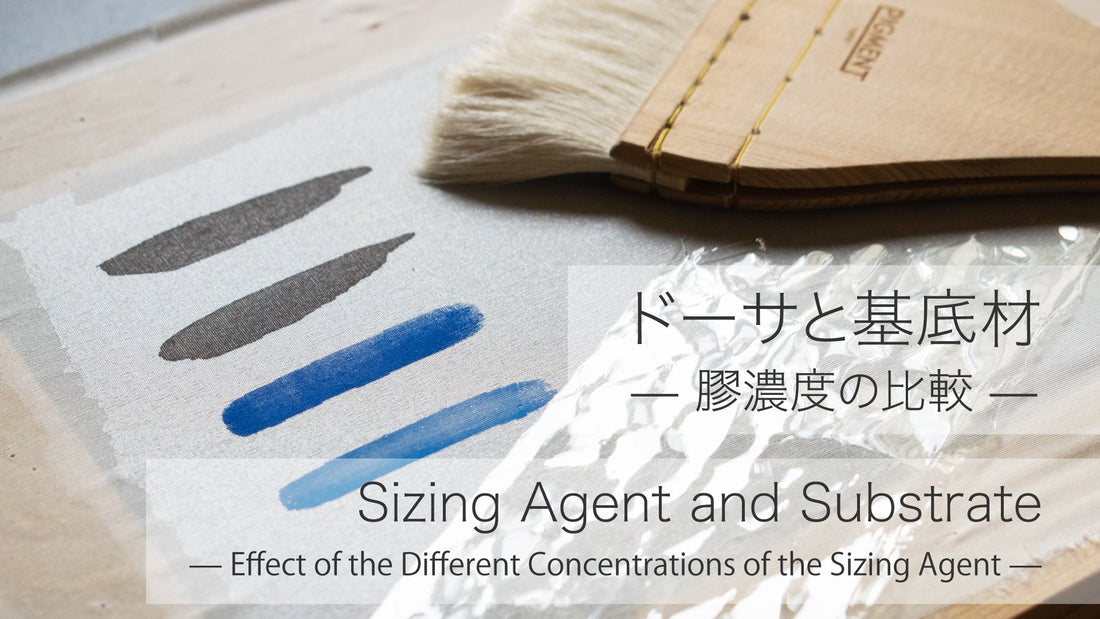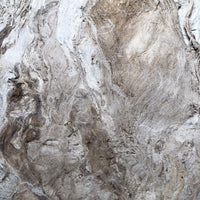Paper and fabric that you can find in art supply stores come in two types: sized and unsized (raw).
Sizing is applied to prevent color blotting or ink bleeding when painting on substrates such as Japanese washi paper, silk canvas, and wood. Sizing refers to the coating process and we call “size” for the liquid used for sizing. In Japan, animal glue-based sizing liquid is commonly used which is called “Dosa (礬水), ” and the sizing technique is also known as Dosa-biki. Dosa is not something that can be manufactured in a certain way and achieve the same effect on all substrates.
Animal glue is made by boiling and refining animal bones and skins which is the reason why they can change their form to preserve the condition and its individual differences thanks to the nature of the materials, therefore, Dosa liquid also requires certain knowledge and understanding of the materials to use it.
Nowadays, although you can find some sized paper in stores, there are still many types of raw paper, and materials like silk, linen and wooden boards mostly require artists to size the substrate themselves. Moreover, for some mounting techniques such as Hyouso framing or Urauchi backing, it is necessary to have artwork on sized washi paper or silk canvas. For example, during the process of Urauchi backing, water is sprayed on the artwork, so color can be spread out from the piece depending on how well it has been coated with sizing liquid.
There is an advantage of doing the whole sizing process by yourself from making sizing liquid to applying even if it’s very time-consuming. It not only increases the choice of base material, but also has the potential to expand the range of gradation and blending of sizing liquid according to color materials, substrates and painting techniques.
However, due to the nature of substrates (like washi paper and silk) with animal glue, which is susceptible to high temperature and humidity, Dosa liquid may not work well depending on the environment and the compatibility with Dosa liquid. It is possible to control this by adjusting the concentration of the sizing solution and the number of times it is applied, but this requires not only knowledge and experience with substrates and color materials, but also researching and collecting data.
At PIGMENT TOKYO, we have created samples by comparing the differences in Dosa concentration on various substrates, so let me introduce some of them here!
In this article, PIGMENT TOKYO’s original animal glue is used for the experiment.
When making Dosa, alum is generally added to enhance the effect of hardening the film of animal glue, but if the glue already has high jelly strength, the film will harden without using alum.
We recommend approximately 3-4% concentration for washi paper and 1.5-2% for silk canvas when making Dosa with our animal glue, however, as I mentioned above, the sizing effect varies depending on the temperature, humidity and substrate, so it is important to adjust the concentration and the layers of application according to your environment and your preference.
There are two types of animal glue we recommend using as Dosa liquid: a sheet type “Pig Skin Glue” and “Pig Glue for Sizing 20%” which is a 20% concentration of the sheet type glue.
Although sheet-type animal glue takes time to make dosas, it can be stored at room temperature for a long period. It’s convenient and is recommended if you plan to make a lot of Dosa. Mold may occur under high temperatures and humidity, so please store it with a desiccant.
◾Kozo-gami
Testing Environment: September 2, 2022, Room Temperature 22.7℃, Humidity 60%.




【Art Materials Used】
Color Materials: Sumi Ink / Shin-iwaenogu (artificial mineral pigments) Gunjo 9, Gunjo 13 / Watercolor /Acrylic Paints
Binders: Animal Glue (used for Shin-iwaenogu)
Substrates: Kozo-gami (5 momme, 10 momme, 15 momme, 20 momme)
Dosa Concentration: 3%, 4%
Layers of Dosa Application: 1 time on the surface
Kozo-gami is made of long and strong fibers, resulting in a paper that is strong, smooth and flexible. It is a multipurpose paper with a wide range of weights from thin/light to thick/heavy.
At 3% concentration, the sizing effect is reasonably effective for all thicknesses of Kozo-gami; while at 4%, the water repellency seems to be stronger and slightly resists color materials. Although 3% allows the ink to stop bleeding for both 15 momme and 20 momme, they absorb more paint than 5 momme and 10 momme.
Since Dosa isn’t fully absorbed into thicker papers like 15 momme or more, be sure to apply it to both the front and back sides of the paper or apply it to more than one layer to avoid uneven coating.
◾Shiromashi
Testing Environment: September 2, 2022, Room Temperature 22.7 ℃, Humidity 60%.

◾Silk
Testing Environment: January 10, 2023, Room Temperature 21 ℃, Humidity 50〜55%.

Since 2 Chohi Tokujo (Delux) is the thinnest, so it has the highest translucency.

These samples are just an example and you can make your own original samples with more detailed information necessary for your practice such as animal glue physical properties, the temperature of the day, humidity, substrates, color materials and other factors.
In the world of artistic expression, of course, interesting results can come out by chance, but the dedication to making the right solution may lead you to the road of becoming a Dosa master!
Translated by Atsumi Okano, Nelson Hor Ee Herng
PIGMENT TOKYO Art Materials Experts








